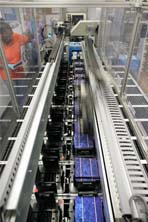Week in review: US solar gets big boosts at federal level
 Let’s see, what happened in solar last week. First two big things in the U.S., the Department of Interior moved forward with making it easier to permit solar on federally managed lands and the Commerce Department upheld its decision on Chinese silicon PV tariffs. And, on an substellar mission solar panels will be used to drill for water on the moon. Meanwhile the increased use of solar and wind will need more backup power, according to a recent study.
Let’s see, what happened in solar last week. First two big things in the U.S., the Department of Interior moved forward with making it easier to permit solar on federally managed lands and the Commerce Department upheld its decision on Chinese silicon PV tariffs. And, on an substellar mission solar panels will be used to drill for water on the moon. Meanwhile the increased use of solar and wind will need more backup power, according to a recent study.
In what may be the biggest news for utility solar development in the U.S. this year, the Department of Interior Secretary Ken Salazar signed into DOI’s codes, the Solar Programmatic Environmental Impact Statement (PEIS), which creates Solar Energy Zones on public lands in the U.S. West. The zones are areas within Bureau of Land Management lands in Arizona, California, Colorado, Nevada, New Mexico, and Utah that were identified as ideal locations for large-scale solar projects. In developing the PEIS, DOI and the Department of Energy sought extensive input from the public and environmental organizations, a relative first for such a program, which helped it gain support among conservation organizations like The Nature Conservancy and The Sierra Club.
The other big news in solar last week, was the U.S. Department of Commerce’s final ruling on upholding trade tariffs on Chinese silicon photovoltaic imports. The deprtment found that China and its solar manufacturers were engaging in unfair trade practices in an attempt to gain marketshare. Under the final determinations the department imposed tariffs as high as 249.96 percent on companies that didn’t participate in the dispute. The dispute was supported by some solar manufacturers like SolarWorld, but opposed by solar manufacturing equipment makers and installers. The latter were concerned that imposing tariffs could raise prices on solar modules.
While solar was originally practically used in space, it’s probably never been used to drill before. That’s how a new robot will search for traces of water on the moon. The robot, Polaris, is contending for a Google X prize and would explore the moon’s poles for traces of water under the surface. Since the atmosphere on the moon is extremely small and has no water vapor, it’s always sunny, allowing the solar panels to power the robot until nightfall, when the solar-charged lithium ion battery takes over.
Not quite as far away, but on the other side of the world, Australia saw the launch of production at its first utility-scale photovoltaic power plant. The 10-megawatt Greenough River Solar Farm was commissioned last week. Near Geraldton, Australia power produced at the plant will help offset the energy used by the Southern Seawater Desalination Plant. The project was financed by U.S.-based GE Energy Financial Services and Western Australian state-owned power utility Verve Energy and developed by First Solar, Inc.
With renewables starting to comprise a larger part of generation capacity in more states, utilities will have to start better managing the flow of electrons by other means. Such means will include natural gas generation, automated demand response and grid storage capabilities, according Lux Research’s new study “Cloudy with a Chance of Energy: Evaluating Technologies to Manage Grid Intermittency”. Among choices, automated demand response, including peak energy shaving, was found the most cost effective way to manage demand. However, it will help manage about 2 percent of peak load—enough for areas where wind and solar comprise up to 10 percent of local loads.
During this campaign season, the same thing that dominated the last election cycle—the economy—continues to dominate the conversation. As such, other issues, like solar and renewable energy have fallen by the wayside, mentioned as secondary issues or even afterthoughts to the economic debate. While solar and wind have their detractors, particularly among conservatives who argue that the nation shouldn’t be subsidizing wind and solar, a larger issue is lost. Why is the U.S. still subsidizing oil, gas, and nuclear energy? Long-term solar incentives would help reduce costs—beyond the subsidies themselves, by showing pricing stability to potential financiers.



